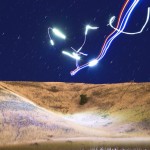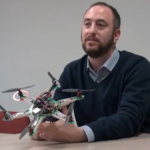By Rachel Nelson
As drones have become a larger part of American culture, through increasing use by individual hobbyists, law enforcement agencies, news organizations and commercial businesses, many Americans are growing increasingly concerned for their right to privacy. A drone itself often does not pose a threat to privacy, however, the development of the technology to carry ever more powerful cameras gives drone operators unprecedented capabilities to invade another’s privacy. Drones equipped with cameras pose a unique threat, as they have the ability to hover, record data, images, or video without someone’s notice, and reach areas that were previously inaccessible, such as a backyard or second-floor window.
As law enforcement agencies nationwide are beginning to integrate drones into their arsenal, many Americans fear not only for their current uses, most notably surveillance, but also the potential for abuses. Drones may be equipped not only with image and video cameras, but also thermal imaging cameras and facial recognition software. Without adequate regulation, some fear that government and police use of drones could lead to the creation of a “federal surveillance state.”
Hobbyist drone pilots pose an additional, perhaps greater, risk to privacy, especially in light of the different regulations governing law enforcement and general citizens. Many Americans fear what Cris Stanton of Pickens County, South Carolina experienced in August of 2015: someone flying a drone “right over our house…To me, that is no different than somebody physically coming onto my property and prowling around,” and echo Stanton’s opinion that “It just feels to me like an invasion of privacy.”
Currently, the FAA has avoided the issue of protecting or addressing privacy concerns and has thus far primarily dealt with safety concerns. In response, the U.S. Department of Commerce’s National Telecommunications Information Administration (NTIA) has released a list of “voluntary best practices” for drone operators to follow. These practices urge drone operators to avoid flying over private property and delete any information gathered by the drone as soon as possible, among others.
However, without clear regulations and consequences for violating those regulations, voluntary practices are not enough. Regulations ought to move beyond voluntary actions to prevent hobbyists from infringing upon another’s privacy in a variety of forms. John Villasenor, a Professor of Engineering at UCLA, identifies “two forms of…invasion of privacy most likely to arise in connection with UAS: intrusion upon seclusion and public disclosure of private facts.”
At the core of the first violation of privacy noted above is whether or not a person has a reasonable expectation of privacy. As David Wolfgang from the Missouri School of Journalism, notes, “privacy laws differ from state to state, but the basic rule is that an individual cannot use technology to peer into a place where a person has a ‘reasonable expectation to privacy.’” In the South Carolina case noted above, the man had a reasonable expectation of privacy within the confines of his home, but the expectation of privacy becomes much less clear outside the home.
Thus regulations should prohibit prolonged surveillance of an individual in both public and private spaces or using drone technology to view areas inaccessible without a drone. For law enforcement, regulations might require a search warrant before using a drone to obtain information they would not otherwise be able to gather. Regulations should also seek to clarify definitions, such as private and public airspace and the bounds within which a person may reasonably expect privacy, as they are currently unclear.
The second violation of privacy deals not with the technology itself but rather how drone operators use the data and images they collect with a drone. Police surveillance is a fact of modern life. Police use technology for anything from surveilling public areas to monitoring cell phone communications. The addition of drones into law enforcement operations would provide them another way to collect information that could be used to solve or prevent crime and increase public safety. Hobbyist drone operators have far greater freedom in what information they can collect and how they can use it simply because they are not held to the same code of conduct as law enforcement.
Hobbyists also maintain a greater level of anonymity than law enforcement and their purposes for collecting images and video is similarly hidden. In a world of increasing suspicion, this added factor causes significant public alarm. One man in Kentucky spotted a drone hovering above his yard where his two daughters were sunbathing. In response, he shot the drone down with a shotgun. He later stated, “[w]e don’t know if they’re pedophiles looking for kids, we don’t know if they’re thieves. We don’t know if it’s ISIS.” Whether or not his concerns are founded is another matter. The point here, is that the concern is present.
Regulation should therefore also be enacted to address this concern. As recommended by the aforementioned best practices, data collected by police should be retained for as little time as possible. However, it is much more difficult to monitor how hobbyist drone operators use the images and video they collect. Hobbyist drone operators might collect images and video that could end up anywhere from news media to social media. Therefore, the best measure to address hobbyist drone photography is to regulate the areas in which they can legally fly the drone.
Finally, news organizations wishing to use drones ought also to comply with regulations that protect and maintain a certain level of citizens’ privacy. Drone technology has allowed for unprecedented access to certain locations and the availability of drones facilitates additional invasions of privacy. For example, these factors have led to the creation of the so-called “dronerazzi.” Therefore, prolonged surveillance, such as following a celebrity, ought to be prohibited as well as using drone photography to disclose facts not previously known to the public.
Thus, regulations for hobbyist and news drones in public spaces should deal primarily with safety as a person cannot expect to maintain privacy in public spaces. In private spaces, regulations should address privacy concerns as well as clearly define what constitutes private and public spaces. In both public and private spaces, regulations should prohibit prolonged surveillance and, in a similar vein, harassment when a drone is not equipped to record images or video.
Drone technology has already proven to have a myriad of beneficial uses. The key to regulation is to provide clear definitions where they currently do not exist and prevent violations of privacy that are likely to result from drone technology.


